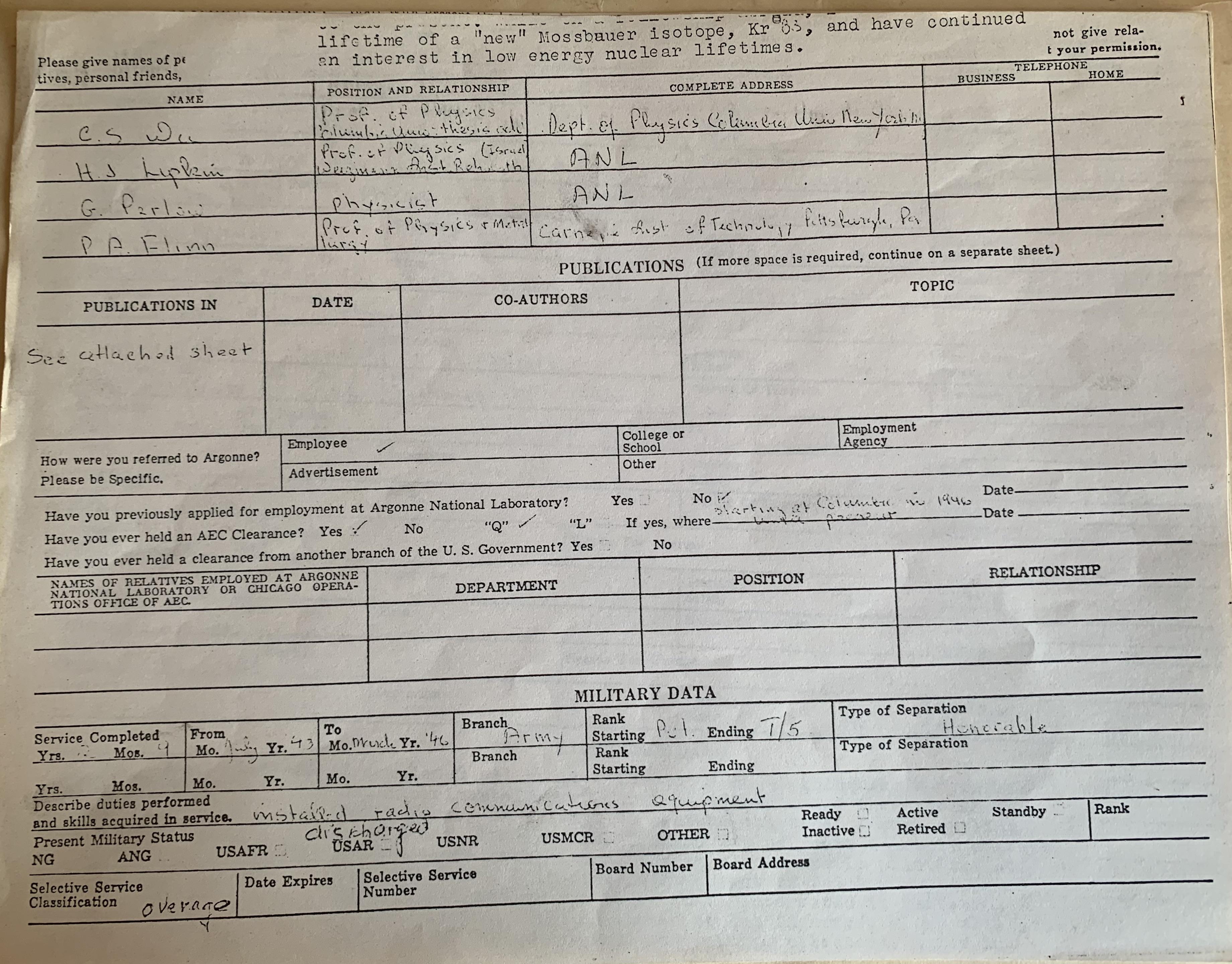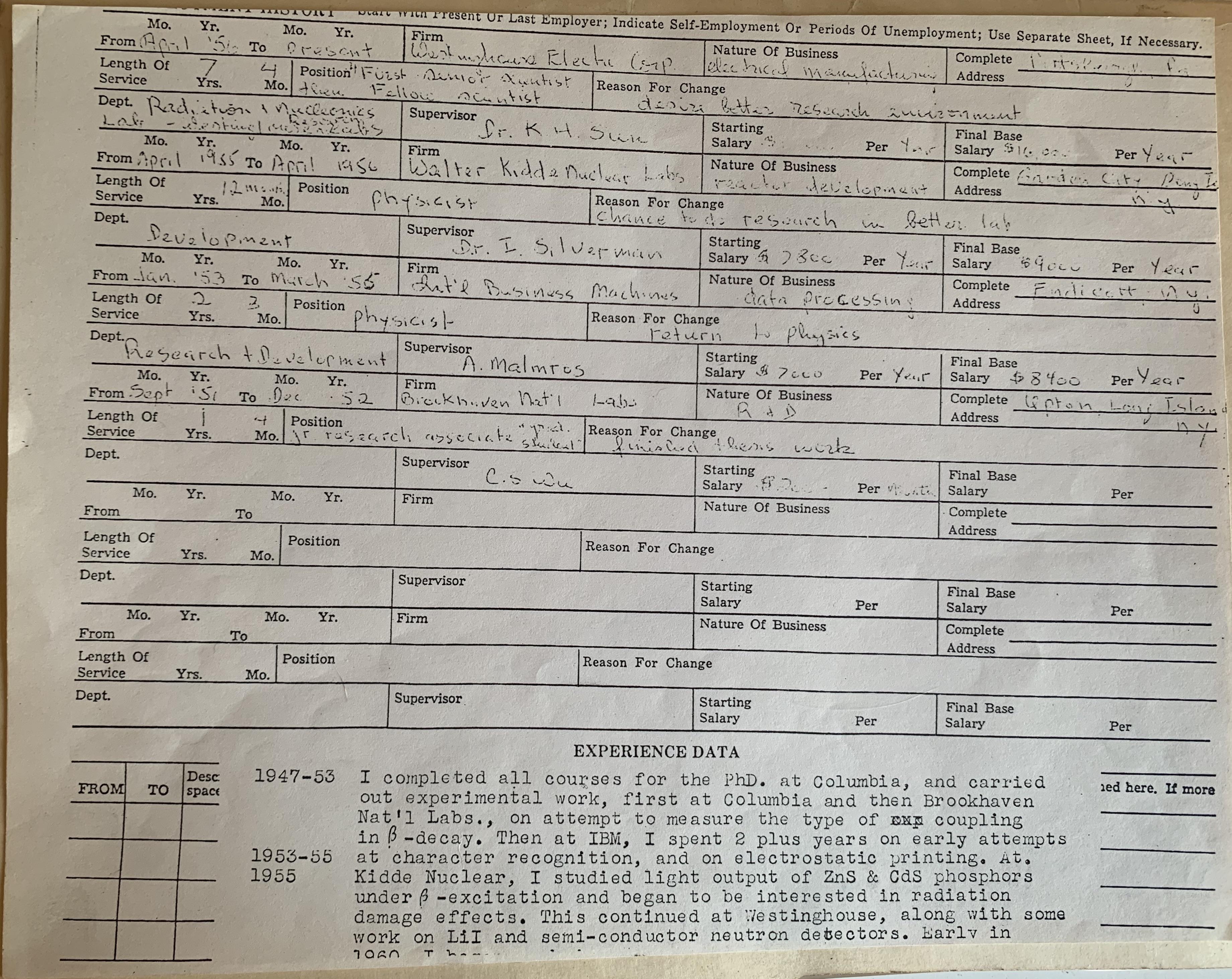Stan listed Wu as a reference in his Argonne employment application form
Also from the CV files, we have photocopies of two pages from a longer employment application form that Stan submitted during his hiring process at Argonne National Laboratory in 1963. It is not dated, but we know that he started the new job in January 1964, so the offer and subsequent HR vetting must have come earlier.
The two pages that we have contain a detailed listing of Stan's employment history, a description of his research interests and accomplishments, the names and addresses of four professional references, publications listing, and military data.
I'll mention the last first since we have recently covered Stan's entry into military service. Here he summarizes his duties performed and skills acquired in service: "Installed radio communications equipment." His service dates, rank (T5), discharge type (Honorable), and current classification (overage) are given.
Under Publications, Stan entered "See attached sheet," and we have that two-page attachment listing 20 of Stan's published papers before 1964, beginning with the two Rustad-Ruby citations.
The Employment History section gives dates and other detailed information about Stan's prior job positions at Brookhaven National Laboratory, International Business Machines, Walter Kidde Nuclear Labs, and Westinghouse Electric Co.
The dates of his Brookhaven employment are given as September 1951 to December 1952. His position held was "junior research associate/graduate student." His supervisor is listed as C.S. Wu. His reason for leaving is "finished thesis work."
A couple of comments on that. The end date is sooner than I had thought because the Brookhaven annual report showed him on staff until June 30, 1952. It seems that our family move to Binghampton/Vestal happened in January 1952, immediately after the first Rustad-Ruby article submission.
Also, I note the unequivocal listing of Wu as his supervisor and the clear indication that his Brookhaven research was also the subject of his thesis work.We see that again in the Accomplishments section, where Stan entered the following.
I completed all courses for the PhD, at Columbia, and carried out experimental work, first at Columbia and then Brookhaven Natl. Labs, on attempt to measure the type of coupling in β-decay.
This makes it entirely clear that the Helium6 recoil experiment of Rustad and Ruby was also the subject of Stan's Ph.D. thesis. That had been uncertain to me before, but now we know that there was no other research topic or thesis submission to consider in our reconstruction of events.
Anything that happened later regarding Stan's Ph.D. candidacy had to have resulted from the Rustad-Ruby work. Thus, even though there is still an unexplained gap in the timeline, we return to the earlier conclusion that it was the later reversal of the experimental result that doomed Stan's doctorate. Now we can set aside any other contributing factors or possible scenarios. We only have to explain why the doctorate was not received at any time before March 1957, when by Wu's own account she first seriously doubted the RR experiment.
Returning to the employment form. In two-plus years at IBM from January 1953 to March 1955, Stan worked on "early attempts at character recognition, and on electrostatic printing." Then in order to "return to physics," he joined Kidde Nuclear, and then a year later for "a chance to do research in a better lab" he joined Westinghouse Research Labs.
He was employed for more than seven years as Senior Scientist and then Fellow Scientist in the Westinghouse Radiation and Nucleonics Lab. His supervisor was Dr. K. Sun, whom we have written about before and will again.
The photocopy of the two pages is missing a line or two of the Accomplishments description covering his Westinghouse years, just as he begins to mention his early Mössbauer work.
His reason for leaving Westinghouse to go to Argonne is given as "desire better research environment."
And now we come to what I think is the most interesting part of this document, the professional references. Four names are given.
C.S. Wu Professor of Physics Columbia University H.J. Lipkin Professor of Physics Weizmann Institute/ANL G. Perlow Physicist Argonne National Lab P.A. Flinn Professor of Physics and Metallurgy Carnegie Inst. of Technology
Lipkin and Perlow are the two Argonne personnel who recruited Stan for the position, so they make perfect sense as references. Paul Flinn was a Carnegie Tech physicist Stan worked with in Pittsburgh and again later at Argonne.
At the top of Stan's reference list is C.S. Wu. It might have been expected that a scientist job applicant would list his or her academic advisor as a reference, and Stan may listed Wu as conforming to the expectation.
But consider that this is about six years following the experiment reversal and whatever consequences resulted from it. Stan had put that behind him and since enjoyed several successes. He might have included her but perhaps not as the first reference.
I'm thinking they may have had an understanding that despite any differences they may have had that he could list her as a reference and that she would give tactfully positive references when contacted. In this case, it is plausible that Gil Perlow, the associate director of the Argonne physics division, would want to contact Madame Wu for a verbal or written reference before signing off on the new hire.
If Perlow specifically asked Stan for Wu's contact, that would explain why she in listed so prominently in his application. Since we are speculating, I am thinking Wu would have replied to Perlow's outreach with a written letter of reference that praised Stan's scientific talent and did not dwell on the details of the experimental work.


